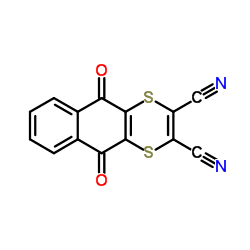3347-22-6
| Name | dithianon |
|---|---|
| Synonyms |
2,3-Dicyano-1,4-dithiaanthraquinone
Thynon 5,10-Dioxo-5,10-dihydronaphtho[2,3-b][1,4]dithiine-2,3-dicarbonitrile Caswell No. 349B Delan-col 5,10-dioxobenzo[g][1,4]benzodithiine-2,3-dicarbonitrile Dithianon Delan 5,10-dihydro-5,10-dioxonaphtho[2,3-b]-1,4-dithiine-2,3-dicarbonitrile EINECS 222-098-6 DITHIANONE MFCD00055492 Delan WP Stauffer MV 119A Stauffer MV-119A Merkdelan 2,3-dicyano-1,4-dithia-anthraquinone 5,10-Dihydro-5,10-dioxonaphtho[2,3-b]-1,4-dithiin-2,3-dicarbonitrile |
| Description | Dithianon is a broad-spectrum anthraquinone fungicide with good adherence to the surface of leaves and fruits. Dithianon is used to control several several fungal of some fruits and vegetables, as anthracnose (Colletotrichum sp., Elsinoe ampelina), mildew (Plasmopara viticola), phomopsis (Phomopsis viticola), among others[1][2]. |
|---|---|
| Related Catalog | |
| Target |
Reactive oxygen species (ROS)[1] Colletotrichum sp.; Elsinoe ampelina; Plasmopara viticola; Phomopsis viticola[1] |
| In Vitro | When exponentially aerobic growing cells of S. cerevisiae are submitted to acute Dithianon treatment they loss cell wall and membrane integrity, dying by necrosis, and this behavior is associated to a depletion of reduced proteic and non-proteic thiol groups. An important increase of cellular reactive oxygen species (ROS) associated to mitochondrial membrane potential modifications on Dithianon treated cells are also detected[1]. In filamentous fungus, Dithianon inhibits mycelial growth and conidial germination. Studies on Ehrlich ascites carcinoma and yeast cells showed that Dithianon inhibits respiration and fermentation affecting several thiol enzymes of the glycolytic pathway as hexokinase, phosphofructokinase, and glyceraldeyde-3-phosphate dehydrogenase[1]. Dithianon has in vitro cytotoxic effect and affect cell transforming activity of BLAB/c 3 T3 cells[1]. |
| In Vivo | The activity of testosterone hydroxylase of liver microsomes derived from male mice is increased when they are treated with acute doses of Dithianon, while in females an inactivating effect is observed[1]. |
| References |
| Density | 1.7±0.1 g/cm3 |
|---|---|
| Boiling Point | 402.1±45.0 °C at 760 mmHg |
| Melting Point | 220ºC |
| Molecular Formula | C14H4N2O2S2 |
| Molecular Weight | 296.324 |
| Flash Point | 197.0±28.7 °C |
| Exact Mass | 295.971405 |
| PSA | 138.20000 |
| LogP | 1.86 |
| Vapour Pressure | 0.0±0.9 mmHg at 25°C |
| Index of Refraction | 1.776 |
| Storage condition | 0-6°C |
CHEMICAL IDENTIFICATION
HEALTH HAZARD DATAACUTE TOXICITY DATA
MUTATION DATA
|
| Symbol |


GHS07, GHS09 |
|---|---|
| Signal Word | Warning |
| Hazard Statements | H302-H410 |
| Precautionary Statements | P273-P501 |
| Personal Protective Equipment | dust mask type N95 (US);Eyeshields;Faceshields;Gloves |
| Hazard Codes | Xn:Harmful;N:Dangerousfortheenvironment; |
| Risk Phrases | R22;R50/53 |
| Safety Phrases | S24-S60-S61 |
| RIDADR | UN 3077 |
| RTECS | QL0700000 |
| Packaging Group | III |
| Hazard Class | 6.1(b) |
